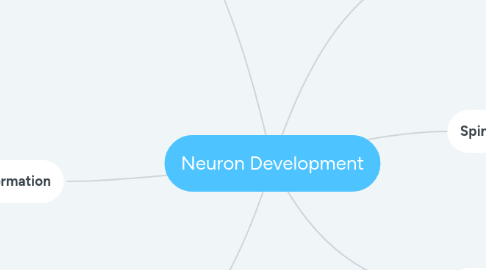
1. Synaptic Formation
1.1. Synapse is a junction at which a neuron transmits a signal to another cell
1.1.1. can be chemical or electrical
1.2. a developing neuron will form multiple synapses
1.2.1. synapses can form between neuron and other neuron, neuron and muscle fibre or neuron and capillaries
1.3. as an organism matures, some synapses are used more frequently and connections strengthen
1.3.1. unused synapse are weakened and do not persist
1.4. neural pruning includes the loss of unused neurons
1.4.1. occurs through removal of axons
1.4.2. influence by environmental factors and mediated by the release of chemical signals form glial cells
2. Neuroplasticity
2.1. describes the capacity for the nervous system to change and rewire synaptic connections
2.2. enables the reinforcement of certain connections (learning) or circumvent damaged regions
2.2.1. rerouting: re-estabilishing and existing nervous connection
2.2.2. sprouting: growth of new axon or dendrite fibres
3. Neuron Development
3.1. Neurons
3.1.1. neural tube contains multipotent neuronal stem cells which can differentiate to form different types of nerve cells
3.1.2. neurons are specialised nerve cells that conduct messages
3.1.2.1. sensory, motor, or rely
3.1.3. glial cells provide nutritional and physical support of the neurons
3.1.4. neurons are produced by progenitor neuroblasts via neurogenesis
3.2. Neural Migration
3.2.1. immature neurons consist of a cell body (soma)
3.2.1.1. axon and dendrites will grow from each immature neuron in response to chemical signals from surrounding cells
3.2.2. an axon has a growth cone at its tip that contains growth filaments called filipodia
3.2.2.1. extensions of filipodia cause expansion of the internal cytoskeleton causing growth
3.2.2.2. the direction of the expansion is controlled by chemical stimuli from surround cells
3.2.2.3. cells may relate grow towards or grow away signals to guide the axon growth - useful for long distances
4. Neurulation
4.1. The folding process that develops the neural plate into the neural tube
4.2. 1. Thickening and elongation of ectoderm 2. Folding of neural plate 3. Convergence of the neural plate 4. Fusion of neural tube 5. Elongation of neural tube
5. Spina Bifida
5.1. The incomplete closure of the embryonic neural tube
5.2. the vertebral processes do not fuse, leaving the spinal cord nerves exposed and prone to damage
5.2.1. the more sever the condition, the more spinal cord exposed leading to increased risk in infection
5.2.2. extremely severe cases may result in paralysis
5.3. Birth defect that can be treated with surgery
6. Strokes
6.1. sudden death of brain cells in a localised area due to inadequate blood flow
6.2. may be temporary if brain recognises neural architecture and restores function
6.2.1. connects to neuroplasticity

